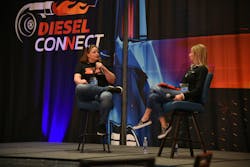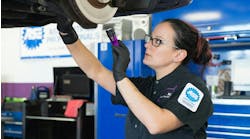Shop owner advice on tech recruiting/retention: "Always be hiring"
PHOENIX—Managing shop budgets and hiring and keeping technicians were among the hot topics discussed by industry professionals gathered at Fullbay's Diesel Connect 2024. The event was held May 6-8 at the cavernous Palo Verde hall of the Gila River Resort & Casino, where heavy-duty diesel shop owners, mobile maintenance technicians, shop managers, and more met to discuss these and other pressing issues.
Recruiting and retention were top of mind for everyone.
“Now our main problem is everybody else's big problem: finding good help,” said Jennifer Wilson, co-owner of Inland Empire Fleet Maintenance, in a panel on shop expansion.
Most in commercial vehicle repair are aware of the numbers: TechForce anticipated that the industry needs 795,000 auto, diesel, collision, and aviation technicians by 2027, while the U.S. Bureau of Labor Statistics projects that there will be over 24,000 openings for diesel mechanics every year until 2032. But with so many heavy-duty leaders in one spot, Diesel Connect wasn’t short on experts offering tactics and solutions to help keep shops staffed.
These solutions included making sure technicians have their career and financial needs met in the shop, especially regarding competitive pay, career advancement, and ongoing training. Also, shops must be hiring people not just for their technical skills but their social ones. Finally, shops must treat hiring and retention as an ongoing problem instead of one that begins and ends with how many bays are staffed on a given day.
“I think that's a real big issue that we have in our industry,” said Jay Goninen, co-founder and president of WrenchWay during the panel ‘How to Recruit More Technicians Without Breaking the Bank.’ “You see that ball coming down at you, you know that [the technician shortage] is an issue, but it's really easy to take your eye off the ball and look elsewhere. It's really easy to have the daily fires take over.”
Retaining techs with pay, benefits, and training
In his presentation on recruiting and retaining technicians, Goninen emphasized that competitive pay, as always, is critical to keeping techs in your shop. Citing numbers from WrenchWay’s Voice of Technician report, Goninen stated that the demand for technicians is driving average pay rates up. For a technician with 0-3 years of experience, the average yearly pay is $57,367; for one with 4-10 years of experience, that number goes up to $75,045 per years; and for those with 11 years or more (with an average of 20 years of experience), the average pay is $93,712.
“That's something that you as a shop have to stay on top of,” Goninen explained. “In the conversations that I've had with shops, a lot of times the technicians know what the other shops are paying better than the shop itself.”
Additionally, managers should be creative with the benefits they offer, with Goninen citing a shop that hired a barber to come in on a monthly basis to cut their techs’ hair.
Of course, pay isn’t all there is to any job, let alone a technician’s. A defined career path is critical to technician retainment, and not just for new hires. According to WrenchWay's Voice of Technician survey, 80% of technicians surveyed wanted a well-documented career path while 92% wanted paid training.
“I know it sounds redundant, because we talk about career path all the time,” Goninen stated. “But what about that 55-year-old technician that doesn't know what their next steps are? Their body is starting to break down and they don't know how they're going to get to retirement.”
And while shops might balk at the cost in both time and money of sending their technicians to training, there are many ways to help cut costs while still keeping technicians up to date.
“We do a daily training called Today's Class in a newsletter,” said Inland Empire Fleet Maintenance’s Wilson. “They basically give them five questions to do every morning, it's five minutes of training, it's all ASE based, so it helps them with getting their ASEs.”
Wilson said she also uses analytics from Today’s Class to understand how her people retain information, which informs who she sends to classroom training.
Read more: Three ways indie repair shops can compete with dealers for technicians
“I look for the techs that retain their knowledge with those analytics,” Wilson said. “Those are the guys that I send to the class, that can sit through the day and retain that knowledge. Then I use those guys to teach the others that may struggle to learn by sitting and staring at a whiteboard or presentation.”
And when it comes to retaining new technicians, shops need to be sure they’re properly supporting their mentors.
“There aren't a lot of great shops at developing that next generation,” Goninen noted. “And if there are, how are you compensating those techs that are teaching this next generation?”
One option he’d seen was a flatbed shop in Austin, Texas, which both paid the technician for mentoring their new people, but also paid him 50 cents on the hour for his mentees’ billable hours for the entirety of their career at the dealership.
“When you look at financial opportunities and how you take care of the technician, I think that approach is brilliant, because ultimately, that person could then go out and recruit their own technicians and start to bring them under their wing,” Goninen explained.
Recruiting technicians for the long run
While shops need to be sure they’re properly showing what makes them unique and the benefits and environment they offer in job postings, Goninen explained, being selective in the applicants they hire is equally important. For Jessica Wendt, owner of HM Repairs and Services, finding technicians who will stick with a shop in the long run means finding someone who fits the shop culture.
“The most important factor is the attitude of the person and not necessarily the skills that they bring,” Wendt explained. “Because if they come in arrogant, I don't want them in my shop, I don’t care how good they are. Because it's not going to help the culture of my shop.”
Wilson agreed, especially since skills can be taught with the training she mentioned earlier.
“It's all about behavior and attitude, because that's inherent,” she said. “Skills can be taught. You can teach anybody anything if they have the right attitude and they have the right behaviors. Those are what you hire.”
As for reaching the right people, Wendt noted that HM Repairs and Services currently advertises for employees through their payroll company, but that previously, they’d used Workstream. This platform lets shops make a single ad and then pitches it out to several platforms at once.
Finally, Wilson emphasized that shops need to keep their hiring pipeline open at all times, not just when they’re down a person.
“Always be hiring,” the co-owner said. “As much as we try to treat our employees like our own, sometimes candidates just walk out the door for a buck.”
And when it can take 3-4 months to find a good replacement, Wilson stated, it’s better to be prepared for anyone to leave than for a shop to rest on its laurels. If shops make hiring one of the daily fires they put out, then they’re already prepared when the technician shortage rears its head.
“Once you think you've got your people, keep that pipeline open, keep resumes coming,” Wilson concluded.






